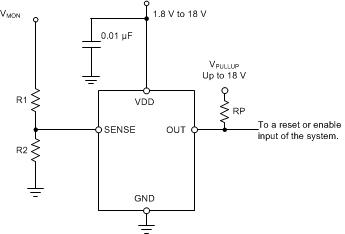SBOS865B January 2018 – November 2019 TLV6703
PRODUCTION DATA.
- 1 Features
- 2 Applications
- 3 Description
- 4 Revision History
- 5 Device Comparison Table
- 6 Pin Configuration and Functions
- 7 Specifications
- 8 Detailed Description
- 9 Application and Implementation
- 10Power-Supply Recommendations
- 11Layout
- 12Device and Documentation Support
- 13Mechanical, Packaging, and Orderable Information
Package Options
Mechanical Data (Package|Pins)
Thermal pad, mechanical data (Package|Pins)
Orderable Information
9.1.1 VPULLUP to a Voltage Other Than VDD
The output is often tied to VDD through a resistor. However, some applications may require the output to be pulled up to a higher or lower voltage than VDD to correctly interface with the reset and enable pins of other devices.
 Figure 14. Interfacing to a Voltage Other Than VDD
Figure 14. Interfacing to a Voltage Other Than VDD